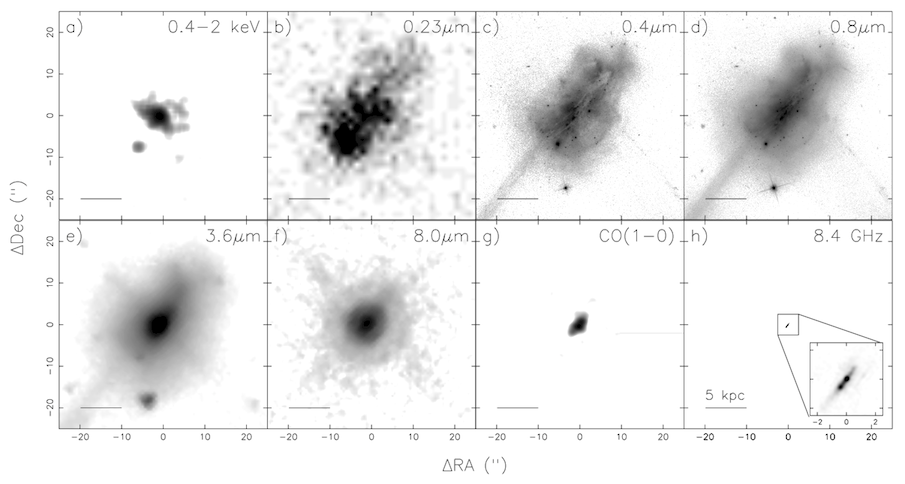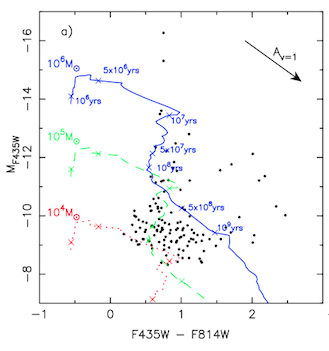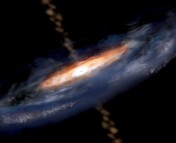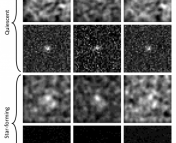Title: Multi-Wavelength GOALS Observations of Star Formation and AGN Activity in the Luminous Infrared Galaxy IC 883
Authors: Frank Modica et al.
First Author’s Institution: Stony Brook University
IC 883 is a nearby luminous infrared galaxy (LIRG) included in the Great Observatories All-sky LIRG Survey (GOALS) and the subject of a recent paper accepted for publication in the Astronomical Journal. To offer a quick review, a LIRG is defined as a galaxy whose infrared luminosity, LIR, is 1011 L☉ < LIR < 1012 L☉. Most of this energy is thermal blackbody radiation from the copious amounts of dust contained in the galaxy, and when you look at the spectral energy distribution of a LIRG (or one of their even more extreme cousins, a ULIRG with LIR > 1012 L☉), you see that this component often exceeds the energy output at shorter wavelengths. Estimates of star formation in these systems hover around ~100 M☉/yr (compared to a few M☉/yr in the Milky Way), but it is unclear what other physical processes are depositing energy in the LIRGs and heating up their dust in addition to this extreme star formation.
We do have a clue, though! Many of the LIRGs observed in the local universe show disturbed morphologies—in other words, LIRGs look like two merging galaxies or two galaxies that have just finished merging. From this merger scenario, it’s not a huge leap to imagine that the disruption caused by the merger triggers the enhanced star formation and black hole activity we see, which in turn fuel the heating of the dust and the enormous infrared luminosity. This idea even provides a reasonable mechanism for the coevolution of galaxies and their central black holes, which is suggested by other observations.
So, understanding what’s going in LIRGs is clearly central to understanding the growth and evolution of massive galaxies, but to really understand what’s going on in galaxies like IC 883, we need to be able to disentangle the contributions of star formation and the active galactic nucleus (AGN) and understand how each changes as a function of a galaxy’s age or merger stage. And to do that, we need to observations at multiple wavelengths.
This explains the motivation behind projects like GOALS and other surveys like COSMOS and GOODS, which probe galaxy evolution at higher redshifts. GOALS combines imaging and spectroscopic data from four space observatories (Spitzer, HST, Chandra, and GALEX) with ground-based data (from observatories like OVRO and the VLA) to investigate the physical processes powering 200 low-redshift LIRGs. As of now, the GOALS team has published a series of papers, including several discussing single merger systems.

Figure 1: Multiwavelength observations of IC 883 displayed in order of increasing wavelength. The images are as follows: (a) Chandra, (b) GALEX, (c,d) HST, (e,f) Spitzer (g) OVRO, (h) VLA. Borrowed from Modica et al. (2011).
In their paper on astro-ph Tuesday, Frank Modica and his collaborators present a multiwavelength view of IC 883 all the way from X-ray (0.4 keV using Chandra) down to radio (8.4 GHz at the VLA). At the longest wavelengths (> 8.0 μm), the bulk of the emission comes from within a few kpc of the central core and is coincident with the primary X-ray emission region. Between 0.1 and 3.6 μm, IC 883 appears to be a classic late stage merger, with a main body ~17 kpc in length and two tidal tails extending roughly 20 kpc to the southeast and southwest, as you can see in the HST images in the figure below. At the optical wavelengths observed with HST, many bright knots are visible in the region around the nucleus and main body of the galaxy, which the authors claim are luminous star clusters formed as a result of the merger.

Figure 2: The color-magnitude diagram for the clusters found in IC 883 are plotted with models that show the evolution of clusters of various masses. Comparison with the models suggest the clusters are on the order of 10-100 Myr old. Borrowed from Modica et al. (2011).
The real highlight of the paper is the analysis of these star clusters, which are uniquely accessible for study in IC 883. After minimizing contamination from background galaxies and foreground stars, the authors confirm the identifications and perform aperture photometry on the 156 candidates which meet their signal-to-noise criteria (S/N > 5σ in both the F435W and F814W bands) and are consistent with being unresolved or only partially-resolved. The approximate range of cluster ages is estimated from the F435W-F814W vs. MF435W color-magnitude diagram (see inset) by comparing the observed locations of the clusters with the model evolutionary track of a 105 M☉ cluster with solar metallicity formed in an instantaneous starburst. This and similar analyses suggest that the majority of the star clusters are consistent with ages on the order of 10-100 Myr (perhaps as low as a few Myr if extinction plays a significant role).
What about AGN activity? Well, in the nuclear region, where the distinct lack of star clusters suggests heavy dust obscuration, the Chandra X-ray and Spitzer IR spectroscopy suggest that star formation is actually the dominant process. If you then make the assumption that the X-ray and far-infrared luminosities are tracing star formation, the star formation rate derived using either the infrared or radio luminosity is ~80 M☉/yr. There is some evidence of weak AGN activity from the luminosity of the high-ionization forbidden [Ne V] 14.32μm emission line, which is too high to be produced only by the remnants of star formation (i.e., supernovae), but the AGN is far less energetic overall than the nuclear starburst.
In summary, multiwavelength observations of IC 883 are consistent with a late-stage merger, where the nuclear emission comes primarily from star formation and a weak AGN. Additionally, the galaxy contains evidence of extended star formation in 156 optically bright star clusters located at a distance ~3-7 kpc from the nucleus, with ages ~10-100 Myr for cluster masses of 105 M☉. Hopefully, I’ve convinced you that using a multiwavelength dataset like the one offered by GOALS can be a powerful tool for probing the astrophysical details of a complex system, but if you’re interested in learning more about the nitty-gritty of this particular object, be sure to take a look at the paper on arXiv!




